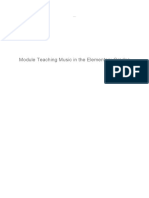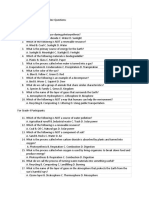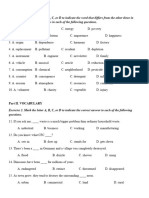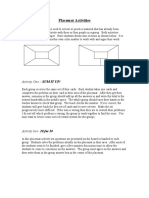0 ratings0% found this document useful (0 votes)
31 views19
19
Uploaded by
Nel BorniaThe document contains 20 multiple choice questions about environmental topics like the objectives of environmental education, influences on the environment from human activities, important stages for environmental education, types of environmental changes and resources, impacts of environmental change, reducing and managing waste, and the importance of environmental awareness. The questions cover a wide range of environmental subjects and have a single correct multiple choice answer for each.
Copyright:
© All Rights Reserved
Available Formats
Download as TXT, PDF, TXT or read online from Scribd
19
19
Uploaded by
Nel Bornia0 ratings0% found this document useful (0 votes)
31 views3 pagesThe document contains 20 multiple choice questions about environmental topics like the objectives of environmental education, influences on the environment from human activities, important stages for environmental education, types of environmental changes and resources, impacts of environmental change, reducing and managing waste, and the importance of environmental awareness. The questions cover a wide range of environmental subjects and have a single correct multiple choice answer for each.
Copyright
© © All Rights Reserved
Available Formats
TXT, PDF, TXT or read online from Scribd
Share this document
Did you find this document useful?
Is this content inappropriate?
The document contains 20 multiple choice questions about environmental topics like the objectives of environmental education, influences on the environment from human activities, important stages for environmental education, types of environmental changes and resources, impacts of environmental change, reducing and managing waste, and the importance of environmental awareness. The questions cover a wide range of environmental subjects and have a single correct multiple choice answer for each.
Copyright:
© All Rights Reserved
Available Formats
Download as TXT, PDF, TXT or read online from Scribd
Download as txt, pdf, or txt
0 ratings0% found this document useful (0 votes)
31 views3 pages19
19
Uploaded by
Nel BorniaThe document contains 20 multiple choice questions about environmental topics like the objectives of environmental education, influences on the environment from human activities, important stages for environmental education, types of environmental changes and resources, impacts of environmental change, reducing and managing waste, and the importance of environmental awareness. The questions cover a wide range of environmental subjects and have a single correct multiple choice answer for each.
Copyright:
© All Rights Reserved
Available Formats
Download as TXT, PDF, TXT or read online from Scribd
Download as txt, pdf, or txt
You are on page 1of 3
1.
The objective of environmental education is
A. Raise consciousness about environmental education
B. To teach environmentally appropriate behavior
C. Create an environmental ethic that fosters awareness about ecological inter-
dependence of economics, social and political
D. All of the above
ANSWER: D
2. Which of the following is not influenced by human activities?
A. Depletion of ground water
B. Destruction of mangroves and wetlands
C. Increased extinction rate of species
D. None of the above
ANSWER: D
3. Environmental education is important only at
A. Primary school stage
B. Secondary school stage
C. Collage stage
D. All stages
ANSWER: D
4. The environment which has been modified by human activities is called
A. Natural environment
B. Anthropogenic environment
C. Modem environment
D. Urban environment
ANSWER: B
5. It is a significant and lasting change weather patterns over long periods.
A. Climate Change
B. Ecological Footprint
C. Carbon Management
D. Sustainable Development
ANSWER: A
6. Amount of natural resources required to sustain our consumption and deal with
our waste.
A. Climate Change
B. Ecological Footprint
C. Carbon Management
D. Sustainable Development
ANSWER: B
7. The process of managing an individual or organization�s emission of greenhouse
gases.
A. Climate Change
B. Ecological Footprint
C. Carbon Management
D. Sustainable Development
ANSWER: C
8. Development that meets the needs of the present without compromising the ability
of future generations to meet their own needs.
A. Climate Change
B. Ecological Footprint
C. Carbon Management
D. Sustainable Development
ANSWER: D
9. The following are the major impacts of environmental change EXCEPT
A. Reforestation
B. Global Warming
C. Ocean Acidification
D. Biodiversity Loss
ANSWER: A
10. Which is true about the happenings of Global Warming?
A. The Earth�s surface has cooled by -0.4 C on average since the 1970s, -1C in last
100 years.
B. There has been a clear increasing trend in Arctic summer sea ice levels since
records began in 1979
C. The sea level around the UK rose by 10cm during the 20th century
D. Human activity over the past 250 years, including reforestation, burning of
fossil fuels has increased the concentration of greenhouse gases in the earth�s
atmosphere.
ANSWER: C
11. Which is an example of renewable resources?
A. Fossil Fuels
B. Hydro Power
C. Radioactive Fuel
D. Metals
ANSWER: B
12. Which is an example of non-renewable resources?
A. Hydro Power
B. Coal
C. Biomass
D. Solar
ANSWER: B
13. In order to minimize the impact of waste products on the environment there are
actions that we can take by
A. Reformat, Reinstall and Reprogram
B. Recalibrate, Redirect and Remake
C. Reduce, Reuse and Recycle
D. Reuse, Reinvent and Recycle
ANSWER: C
14. This type of waste which contains hazardous substances, may cause harm to the
environment or react with other materials.
A. Hazardous
B. Non-Hazardous
C. Clinical
D. Inert and Active
ANSWER: A
15. These are building waste such as rubble, brick, stone and wood.
A. Hazardous
B. Non-Hazardous
C. Clinical
D. Inert and Active
ANSWER: D
16. This type of wastes are can be found in hospitals and clinics.
A. Hazardous
B. Non-Hazardous
C. Clinical
D. Inert and Active
ANSWER: C
17. Which of the following a proper way to reduce?
A. buy things with less packaging
B. reuse wrapping
C. repair rather than dispose
D. reuse coffee cups
ANSWER: A
18. The following are recyclable resources EXCEPT
A. Plastics
B. Ink Cartridges
C. Glass
D. Glossy Materials
ANSWER: D
19. It means being aware of the natural environment and making choices that benefit
the earth, rather than hurt it.
A. Environmental Destruction
B. Environmental Protection
C. Environmental Awareness
D. Environmental Development
ANSWER: C
20. Why do we need to study environmental awareness?
A. It helps students understand how their decisions and actions affect the
environment
B. It promotes dishonesty and socially destructive
C. It promotes intolerance of different points of view and different cultures.
D. It helps learners see the disconnection of social, ecological, economic,
cultural, and political issues.
ANSWER: A
You might also like
- Gestures - Vilém FlusserDocument208 pagesGestures - Vilém FlusserrachelcocNo ratings yet
- College Math Placement TestDocument2 pagesCollege Math Placement TestNel BorniaNo ratings yet
- Tao of Revitalization: Exercises For Self-HealingDocument25 pagesTao of Revitalization: Exercises For Self-HealingAnirudh100% (2)
- Module Teaching Music in The Elementary Grades: Lomoarcpsd - 5406869Document30 pagesModule Teaching Music in The Elementary Grades: Lomoarcpsd - 5406869Nel Bornia100% (3)
- Environnemental Science TestbankDocument41 pagesEnvironnemental Science TestbankTim Weaver75% (4)
- MCQS Set For Est (22447)Document20 pagesMCQS Set For Est (22447)shaaaxx33No ratings yet
- MCQ (All)Document19 pagesMCQ (All)AABHINo ratings yet
- HS Mở Rộng Kiến Thức SGK Anh Văn 12 Buổi 2Document5 pagesHS Mở Rộng Kiến Thức SGK Anh Văn 12 Buổi 2anhhao1029384756No ratings yet
- HS Unit 3 Test 2Document3 pagesHS Unit 3 Test 2hoangbichloan67No ratings yet
- GV UNIT 3 TEST 2Document3 pagesGV UNIT 3 TEST 2Nguyễn Ái Vân Trường THPT Chuyên Lê Quý ĐônNo ratings yet
- Tiếng anh GLOBAL SUCCESS 12 BÀI TẬP LÀM THÊM - UNIT 3 (BUỔI 2) -GVDocument3 pagesTiếng anh GLOBAL SUCCESS 12 BÀI TẬP LÀM THÊM - UNIT 3 (BUỔI 2) -GVnguyenduongpp24022007hnNo ratings yet
- Final Exam GE10 People and Earths Ecosystem by CEAlarbaDocument8 pagesFinal Exam GE10 People and Earths Ecosystem by CEAlarbachris ian100% (2)
- BÀI TẬP LÀM THÊM - UNIT 3 (BUỔI 1) -HSDocument3 pagesBÀI TẬP LÀM THÊM - UNIT 3 (BUỔI 1) -HSthảo vânNo ratings yet
- Est MCQDocument12 pagesEst MCQshreyadc6No ratings yet
- BT Unit 6Document20 pagesBT Unit 6Thuỳ LinhNo ratings yet
- Survey Questionnaire (Bped 1-b)Document3 pagesSurvey Questionnaire (Bped 1-b)research extension0% (1)
- Model Exam 2Document24 pagesModel Exam 2palnhialkoang883No ratings yet
- CI MCQ FORMATTED 214 QuestionsDocument34 pagesCI MCQ FORMATTED 214 QuestionsmanavNo ratings yet
- Summative Test Week 8 Science 4Document4 pagesSummative Test Week 8 Science 4jessamyn.rosarioNo ratings yet
- Position The of The Primary Stress in Each of The Following QuestionsDocument9 pagesPosition The of The Primary Stress in Each of The Following QuestionsTrúc LinhNo ratings yet
- Environmental Science Set 1Document5 pagesEnvironmental Science Set 1Syed WarnaNo ratings yet
- G9 Corrected Summative ExamDocument7 pagesG9 Corrected Summative ExamAnie Rose TiuNo ratings yet
- BÀI TẬP UNIT 5 ENG 11Document31 pagesBÀI TẬP UNIT 5 ENG 11contact.maxographyNo ratings yet
- Long Quiz 1Document1 pageLong Quiz 1Nathaniel TolentinoNo ratings yet
- HS Mở Rộng Kiến Thức SGK Anh Văn 12 Buổi 1Document3 pagesHS Mở Rộng Kiến Thức SGK Anh Văn 12 Buổi 1anhhao1029384756No ratings yet
- CLASSWORK2 Goals and Importance of Environmental Science Different Field of Sciences Related To Environmental ScienceDocument3 pagesCLASSWORK2 Goals and Importance of Environmental Science Different Field of Sciences Related To Environmental ScienceMichelle Gutierrez SibayanNo ratings yet
- Reading ENVIRONMENTDocument5 pagesReading ENVIRONMENTkudo shinichiNo ratings yet
- ĐỀ THI CUỐI KÌ 1 -TEST 7-LỚP 11Document7 pagesĐỀ THI CUỐI KÌ 1 -TEST 7-LỚP 11phamthaihahbNo ratings yet
- Revision For Final Exam - Unit 5Document8 pagesRevision For Final Exam - Unit 5Nam TửNo ratings yet
- 2nd Exam Envisci7 2022Document5 pages2nd Exam Envisci7 2022Liezl ValienteNo ratings yet
- ĐỀ CƯƠNG CUỐI KỲ 1 -TEST 10-LỚP 11Document7 pagesĐỀ CƯƠNG CUỐI KỲ 1 -TEST 10-LỚP 11minghinffNo ratings yet
- VocabDocument70 pagesVocabYến NhiiNo ratings yet
- Đề Thi Cuối Kì 1 -Test 10-Lớp 11Document7 pagesĐề Thi Cuối Kì 1 -Test 10-Lớp 11phamthaihahbNo ratings yet
- Review 2Document9 pagesReview 2LONG TRẦN MINH HOÀNGNo ratings yet
- Eco Quiz Bee - Final QuestionsDocument5 pagesEco Quiz Bee - Final QuestionsChristine Joy Perion50% (2)
- Homework Unit 5 2710 E11Document8 pagesHomework Unit 5 2710 E11tuantudzxxNo ratings yet
- Question Bank EST 3Document4 pagesQuestion Bank EST 3pranjalghatge18No ratings yet
- Unit 6 Global WarmingDocument12 pagesUnit 6 Global WarmingNlt Mỹ LinhNo ratings yet
- Q1 Science 4Document4 pagesQ1 Science 4jenevie.ruizNo ratings yet
- 665060395-1622415051477-Plus1 Pro3mplusbai91 Tuvungchuyensauchudeenvironmentbuoi1Document2 pages665060395-1622415051477-Plus1 Pro3mplusbai91 Tuvungchuyensauchudeenvironmentbuoi1Hòa Triệu KhánhNo ratings yet
- ES Revision Sheets - Multiple Choice Questions With Answers 2024Document4 pagesES Revision Sheets - Multiple Choice Questions With Answers 20244p5zrbdzbwNo ratings yet
- LiFE QuizDocument7 pagesLiFE QuizBalwinder SinghNo ratings yet
- Questionnaire For Environmental Science and Related IssuesDocument6 pagesQuestionnaire For Environmental Science and Related IssuesChristine Joy PerionNo ratings yet
- Unit 10Document17 pagesUnit 10my hoàngNo ratings yet
- Environmental Science Quiz 2017Document17 pagesEnvironmental Science Quiz 2017caridad.quibanNo ratings yet
- Environmental Crisis and Concerns QuizDocument5 pagesEnvironmental Crisis and Concerns QuizKyla Mae MaislingNo ratings yet
- Environmental Crisis and Concerns QuizDocument5 pagesEnvironmental Crisis and Concerns QuizKyla Mae MaislingNo ratings yet
- Fourth Written Test in Science 8 QUARTER 4, SY 2021-2022 Instructions: Read Each Question Carefully and Write The Correct Answer in ADocument5 pagesFourth Written Test in Science 8 QUARTER 4, SY 2021-2022 Instructions: Read Each Question Carefully and Write The Correct Answer in Ajoan marie PeliasNo ratings yet
- Đề Thi Cuối Kì 1 -Test 8-Lớp 11Document7 pagesĐề Thi Cuối Kì 1 -Test 8-Lớp 11phamthaihahbNo ratings yet
- Unit 9 Và 10 Key - BTTA 140cDocument56 pagesUnit 9 Và 10 Key - BTTA 140cĐào NgânNo ratings yet
- 200G1-Environmental Awareness (UG Computer Science)Document20 pages200G1-Environmental Awareness (UG Computer Science)gaurav gautamNo ratings yet
- EST question bank 2Document3 pagesEST question bank 2pranjalghatge18No ratings yet
- State University of New York College of Technology Canton, New York Course Outline Esci 101 - Introduction To Environmental ScienceDocument6 pagesState University of New York College of Technology Canton, New York Course Outline Esci 101 - Introduction To Environmental Sciencekumo murasakiNo ratings yet
- Multiple ChoiceDocument3 pagesMultiple Choicegladys.tuvieronNo ratings yet
- Part I. Phonetics: Unit 9 - Preserving Environment Worksheet No. 3Document6 pagesPart I. Phonetics: Unit 9 - Preserving Environment Worksheet No. 3Thien Duc VanNo ratings yet
- Review Unit 6+7 MơiDocument8 pagesReview Unit 6+7 MơiDistress100% (1)
- NSTP CWTS 12 Mid Term ExamDocument3 pagesNSTP CWTS 12 Mid Term ExamShaira Staana100% (1)
- Dap An Phan On TapDocument6 pagesDap An Phan On TapphedetranNo ratings yet
- Unit 6Document6 pagesUnit 6Trần Hương QuỳnhNo ratings yet
- Unit 5 - Test 1Document6 pagesUnit 5 - Test 1Emma EmmaNo ratings yet
- Topic 5 Natural in Danger - PNT Da Chinh SuaDocument6 pagesTopic 5 Natural in Danger - PNT Da Chinh SuaPhạm Ngọc TrâmNo ratings yet
- Environmental-Science (Set 1)Document21 pagesEnvironmental-Science (Set 1)pubgpure505No ratings yet
- Pat Genap KLS 8 2023-2024Document12 pagesPat Genap KLS 8 2023-2024feny risdianaNo ratings yet
- SCIENCEDocument3 pagesSCIENCENel BorniaNo ratings yet
- Change of Grade IndividualDocument2 pagesChange of Grade IndividualNel BorniaNo ratings yet
- Renz ProjectDocument4 pagesRenz ProjectNel BorniaNo ratings yet
- Test Evaluation TemplateDocument22 pagesTest Evaluation TemplateNel BorniaNo ratings yet
- ENLISHDocument3 pagesENLISHNel BorniaNo ratings yet
- Expressive, Optimistic, Outgoing, and Inspiring: NON BINARY-Vice Ganda Is A Name That Indicates A Gift ofDocument2 pagesExpressive, Optimistic, Outgoing, and Inspiring: NON BINARY-Vice Ganda Is A Name That Indicates A Gift ofNel BorniaNo ratings yet
- BPEDDocument2 pagesBPEDNel BorniaNo ratings yet
- Request LetterDocument1 pageRequest LetterNel BorniaNo ratings yet
- ASL 1 Course GuideDocument12 pagesASL 1 Course GuideNel BorniaNo ratings yet
- Uniform LetterDocument1 pageUniform LetterNel Bornia100% (1)
- FS 411-Field Study 1Document19 pagesFS 411-Field Study 1Nel BorniaNo ratings yet
- FS 2 Course GuideDocument13 pagesFS 2 Course GuideNel BorniaNo ratings yet
- FSMQ Algebraic ExpressionsDocument5 pagesFSMQ Algebraic ExpressionsNel BorniaNo ratings yet
- TTL 1 Course GuideDocument13 pagesTTL 1 Course GuideNel BorniaNo ratings yet
- College and Advance Algebra Self-Learning ModuleDocument137 pagesCollege and Advance Algebra Self-Learning ModuleNel BorniaNo ratings yet
- Course Outline and Learning PlanDocument30 pagesCourse Outline and Learning PlanNel BorniaNo ratings yet
- Assessment in Student Learning 1Document16 pagesAssessment in Student Learning 1Nel BorniaNo ratings yet
- Building and Enhancing Course GuideDocument11 pagesBuilding and Enhancing Course GuideNel Bornia100% (1)
- Course GuideDocument12 pagesCourse GuideNel BorniaNo ratings yet
- Implementing Problem Solving in Mathematics ClassrDocument9 pagesImplementing Problem Solving in Mathematics ClassrNel BorniaNo ratings yet
- Building and Enhancing New Literacies Across The Curriculum: Lomoarcpsd - 5406869Document12 pagesBuilding and Enhancing New Literacies Across The Curriculum: Lomoarcpsd - 5406869Nel BorniaNo ratings yet
- Placemat Activities: Activity One - SUM IT UP!Document8 pagesPlacemat Activities: Activity One - SUM IT UP!Nel BorniaNo ratings yet
- 17Document3 pages17Nel BorniaNo ratings yet
- Course Content OverviewDocument5 pagesCourse Content OverviewNel BorniaNo ratings yet
- 9Document2 pages9Nel BorniaNo ratings yet
- MMW (Midterm Pretest and Post Test Exam)Document4 pagesMMW (Midterm Pretest and Post Test Exam)Nel BorniaNo ratings yet
- Principles of Teaching 1 QuizDocument2 pagesPrinciples of Teaching 1 QuizNel Bornia100% (1)
- Course Manual Public International Law Ba LLB/ Bba LLB - 2018Document22 pagesCourse Manual Public International Law Ba LLB/ Bba LLB - 2018Rakshitha VijayNo ratings yet
- A Primer On Opinion LettersDocument32 pagesA Primer On Opinion Lettersseti2016No ratings yet
- Chapter 3 Environmental Management SytemsDocument16 pagesChapter 3 Environmental Management Sytemsellaysabuag3No ratings yet
- Ee6303 Lica 2 Marks With Answers - RejinpaulDocument48 pagesEe6303 Lica 2 Marks With Answers - Rejinpaulsrajece100% (1)
- IGCARDocument2 pagesIGCARKathirselvamNo ratings yet
- VR Hackers - Risk Assesment Hacking-2Document3 pagesVR Hackers - Risk Assesment Hacking-2Vikas RameshNo ratings yet
- Na Thalia MapDocument118 pagesNa Thalia MapjackyspNo ratings yet
- Personal Factors CPALEDocument113 pagesPersonal Factors CPALEGrashiela CalimlimNo ratings yet
- 2.1 Fuels and Combustion PDFDocument39 pages2.1 Fuels and Combustion PDFKantilal MalwaniaNo ratings yet
- Analysis of The Trans - Cinnamic Acid Content in CiDocument7 pagesAnalysis of The Trans - Cinnamic Acid Content in CiwaelNo ratings yet
- Building Your Personal Brand: Inspired PerformanceDocument34 pagesBuilding Your Personal Brand: Inspired PerformanceafaqNo ratings yet
- Draft Handout English IntermediateDocument20 pagesDraft Handout English Intermediateandro prasetioNo ratings yet
- C96-98-3640 Error Codes (917 Error Fatal) PDFDocument4 pagesC96-98-3640 Error Codes (917 Error Fatal) PDFArmandoPerezNo ratings yet
- Determining Ka For Ethanoic AcidDocument2 pagesDetermining Ka For Ethanoic AcidShannon GrahamNo ratings yet
- TABLE B4.1a Width-to-Thickness Ratios: Compression Elements Members Subject To Axial CompressionDocument2 pagesTABLE B4.1a Width-to-Thickness Ratios: Compression Elements Members Subject To Axial Compressionbryamdv23100% (1)
- 2022 2023 Ingilizce 7. Sinif Dyk Kurs PlaniDocument16 pages2022 2023 Ingilizce 7. Sinif Dyk Kurs PlaniMustafa KutanNo ratings yet
- Pls. Recheck - Bucit List 2024 For Program PreparationDocument8 pagesPls. Recheck - Bucit List 2024 For Program Preparationbuenaobracarren84No ratings yet
- Poverty in The Philippines - Causes, Constraints and Opportunities - Asian Development BankDocument4 pagesPoverty in The Philippines - Causes, Constraints and Opportunities - Asian Development BankKim TaehyungNo ratings yet
- SpinalHDL: A Comprehensive Hardware Description LanguageDocument1 pageSpinalHDL: A Comprehensive Hardware Description LanguageMeenakshi JainNo ratings yet
- Functional Specification: Liquid Knock Out Vessels 1440 Psi and 250 PsiDocument14 pagesFunctional Specification: Liquid Knock Out Vessels 1440 Psi and 250 PsiNaba Kumar RoyNo ratings yet
- 2wvzq79gvycokolywolffkan 325-Sl Tower Crane NetworkDocument6 pages2wvzq79gvycokolywolffkan 325-Sl Tower Crane NetworkdjlivuNo ratings yet
- Topic:TENSES: Present Tense, Past Tense and Future TenseDocument8 pagesTopic:TENSES: Present Tense, Past Tense and Future TenseRoma ThakkarNo ratings yet
- The Essential Can DuDocument1,144 pagesThe Essential Can DuEddie RomanNo ratings yet
- Literature Review - 2024Document10 pagesLiterature Review - 2024Pratima MandadiNo ratings yet
- F 10 SolutionsDocument7 pagesF 10 SolutionsSwarup GhoshNo ratings yet
- Kai (3) .SQLDocument4 pagesKai (3) .SQLbinomo binomoNo ratings yet
- Sesión 1.3. Cyclical Vs Counter-Cyclical StockDocument4 pagesSesión 1.3. Cyclical Vs Counter-Cyclical StockVictorTRNo ratings yet
- The Inspiring Story of Suresh KamathDocument4 pagesThe Inspiring Story of Suresh Kamathvishal_000No ratings yet






















































































































